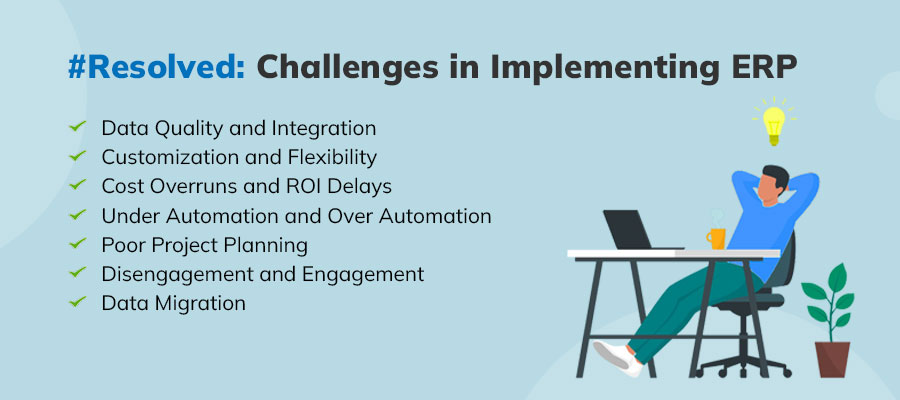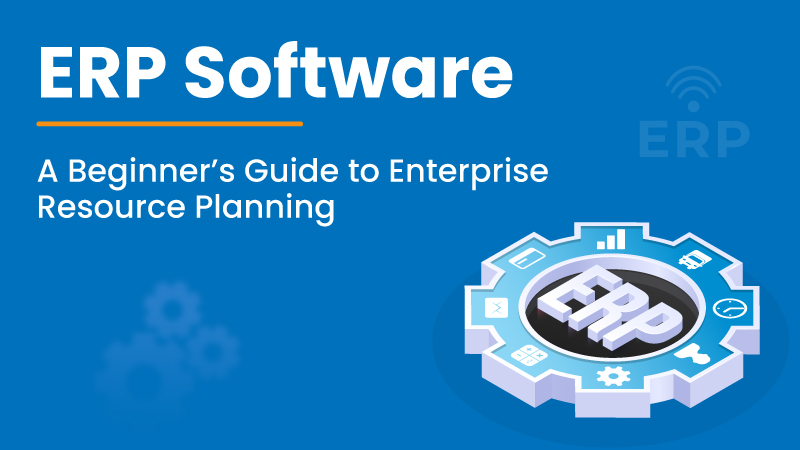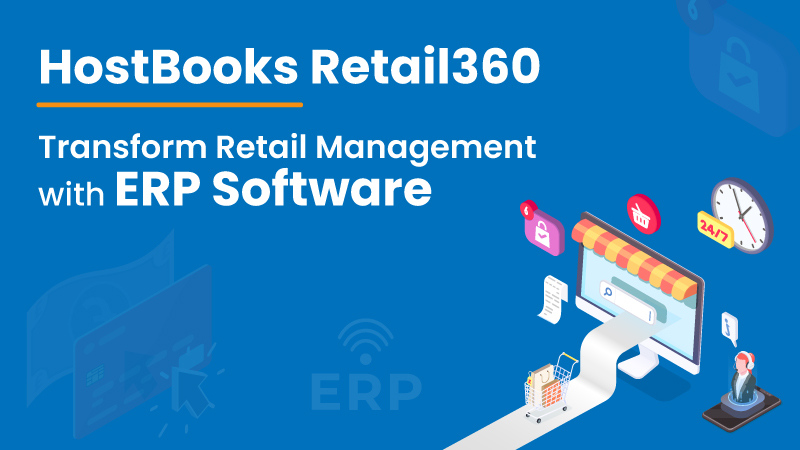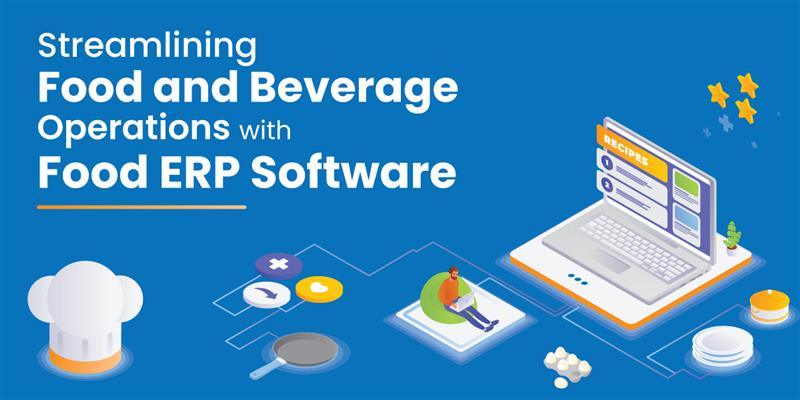Challenges in Implementing ERP 2024: Beyond Basics (Solutions Included)

Enterprise Resource Planning (ERP) systems are by far the most technical aspect of any organization operations. It functions as the heart of an enterprise, synchronizing every system -every task- every process into a single chain.
Implementing ERPs is extremely challenging. Connecting all aspects of operations from systems, devices, people, product, and processes is resource extensive. A successful implementation could even take up to 5 years for a large enterprise.
But this article isn’t about scaring you – it’s about making sure that you know the upcoming complexities if you are going to implement an ERP so that you can make plans to reduce cost, time and risks associated with the ERP implementation.
I haven’t created this article out of thin air. I have interviewed and drawn insights from firsthand experiences of CXOs and ERP consultant, multiple ERP case studies, and customer success stories of ERP solution provider to incorporate the best of information.
ERP Implementation Challenges Bifurcation
The challenges while implementing ERP could differ based on the situation, size, industry, and past history with ERP. We have split the challenges for better information feed.
- 1. Generic Challenges
- 2. First-Time ERP Implementation Challenges
- 3. Shifting to New ERP Challenges
- 4. Bonus (scroll to read)
Why is ERP Implementation So Hard?
ERP are supposed to be the one stop for all the process – from billing to raising purchase orders- ERP is supposed to replace every other used in an organization.
Here are 4 major reasons by ERP implementation is such a big deal.
- 1. A Mission Critical System: ERP systems should leave no room for failure. Ensuring reliability and safety requires complex redundant systems, extensive testing, and quality assurance processes.
- 2. Complex Business Processes: Business processes are diverse and complicated, spanning across locations and jurisdictions. ERP should connect everything, ensure data flow, integrity, right workflow, and hundreds of other parameters.
- 3. Custom Code: The custom coding required to tailor the ERP to meet the specific requirements of the business makes the system complex and less agile.
- 4. Applications Built on Top of the ERP System: External apps (smartphone apps) often built outside the ERP system for remote control poses difficulties with ERP implementation
Generic Implementation Challenges of Enterprise Resource Planning
Resistance to Change
Resistance to change is primarily rooted in human dynamics within organizations. This resistance often stems from fear of the unknown, comfort with familiar systems, and inadequate communication.
Despite the evident benefits, employees often exhibit reluctance due to fear of job role alterations, lack of understanding, or sheer attachment to existing processes. This human element becomes a crucial factor influencing the success of the entire project.
Understanding the Psychology
The "mindshift" problem arises from ingrained habits and perceptions. Users, accustomed to established processes, may find it hard to embrace new methods without immediate, visible advantages. Comments like "It's always been like this" or "I don't think it will work" reflect the underlying resistance.
How to Overcome Resistance?
- Strategic Approach to User Buy-In: Gaining interest, involvement, and support from diverse user groups early in the project minimizes pushback during critical phases. Ensuring employees see the advantages before implementation begins is key.
- Change Management Tactics: Informing employees of project milestones, establishing reliable feedback channels, and stimulating idea generation create a culture of collaboration. Providing training sessions and celebrating user achievements fosters a positive environment, making users more receptive to the impending changes.
While the ERP system follows logical processes, users' attitudes, habits, and understanding of what's best for the business play a pivotal role. Ignoring this human dimension jeopardizes project goals.
Data Quality and Integration
Data is the most important aspect of any organization and faulty data or data that’s not in readable format is unacceptable.
When organizations transfer their legacy data into a new ERP system or from one ERP to another, they encounter the complex task of ensuring seamless integration and maintaining data quality. Old data, used and stored over the years, may appear approximate or even incorrect in the new ERP reality.
The Gravity of the Problem:
As the ERP system serves as a comprehensive library of essential business information, discrepancies in data quality mirror a disorganized library. In this scenario, crucial insights become challenging to retrieve, akin to searching for books in a disorderly collection. Inaccuracies and inconsistencies in data can negatively impact the performance and reliability of the ERP system.
The implications extend to informed decision-making, streamlined processes, and overall operational efficiency.
Solution and Mitigating Risk
- Plan and test every aspect: Invest in meticulous planning and execution during the data transfer process. Rigorous data management process is crucial for maintaining the integrity of information within the ERP system.
- Leverage tech and implement damage control: Utilize technologies and practices that ensure data accuracy, accessibility, and relevance for every process in the organization. Continuous monitoring and validation mechanisms should be in place to rectify discrepancies promptly.
Customization and Flexibility
Organizations strive to align the system with their unique workflows and processes. Excessive customization can lead to increased complexity, higher maintenance costs, and difficulties in future upgrades.
Striking the right balance becomes a critical aspect while tailoring the ERP to their requirements and maintaining the system's adaptability for long-term efficacy.
The Solution
Organizations should conduct a thorough analysis of their specific requirements, distinguishing between essential customizations and those that might introduce unnecessary complexity. The solution involves choosing an ERP system that provides a balanced level of flexibility without sacrificing core functionalities.
User Adoption and Training
Comprehensive user training is crucial in ERP implementation to ensure each user understands their role and the complexities of the new system. Inadequate training amplifies this issue, leading to productivity hindrances and user frustration.
Solution
Investing in ERP with comprehensive training programs, modules, tutorials, and robust documentation. Also leverage tools like Digital Adoption Platforms streamline onboarding and ensure ongoing skill refinement.
Cost Overruns and ROI Delays:
ERP implementations are infamous for running out of budget most of the time. There are three key reasons for this:
- 1. Inadequate Planning for the Unknown: The complexity of today’s modules and the need for active interaction can push budgets beyond limits. Simply projecting based on established requirements is not enough. Expecting the unexpected is crucial, and a general cost overrun of budget-plus 30% is common.
- 2. Overlooking 'Soft Costs': Developing sensible system requirements is hard work, but final budgeting often misses 'soft costs.' These include training time, potential operational downtime, external contract costs, and indirect expenses related to extended infrastructure.
- 3. Failure of Understanding the Enterprise: Known as 'horizontal scoping,' this failure occurs when practical constraints alter ERP system capabilities. If managers don't comprehend daily enterprise operations, they risk selecting the wrong ERP system for their company.
Tips to Prevent Cost Overrun
Avoiding ERP budget overruns requires careful consideration of key challenges. Data conversion, often underestimated, demands attention to import, reconciliation, and data preparation timelines. Clear reporting requirements, beyond standard options, must be specified with allocated budgets.
Integrating ERP with third-party applications requires detailed scope definition and collaboration. Managing development projects as mini projects within the broader framework necessitates careful scope, project management, communication, and realistic timelines.
First-Time ERP Implementation Problems
Selection Problem
Insufficient research and selection in the initial stages of ERP implementation can lead to several consequences. The most critical impact is often delayed implementation, where the organization invests more time than planned due to revisiting software choices.
The risk of suboptimal system fit is grave, potentially resulting in a system that does not align with specific organizational needs, diminishing overall performance.
Tip
Organizations should prioritize a thorough analysis of their requirements, seeking expert guidance and considering pilot programs to evaluate software suitability before committing to full-scale implementation.
Technical Issues
Technical issues in ERP implementation present formidable challenges, including the imperative for an infrastructure overhaul, network considerations, mobile compatibility, and data migration challenges. Inadequate planning may lead to system downtime, reduced efficiency, connectivity problems, limited accessibility, compromised data integrity, and potential security risks.
Mitigating Technical Risk
Organizations should conduct early assessments of technical requirements, consider cloud adoption to alleviate on-premises challenges, and ensure the chosen ERP system can scale with evolving technical needs.
Hiring and Employee Training Issues
First time ERP implementation requires business to hire and train staff that are familiar or competent enough to run ERP. If the entity is unable to hire or train the staff the consequences include inefficient system use, loss of data and even disturbance in operations.
Creating a Right Team
Reverse working could be a great solution – choosing an ERP for with there already exists a good workforce or implementing an ERP with is easy to learn. Also, implement comprehensive training programs to familiarize employees with the new system, and utilize Digital Adoption Platforms (DAPs) for enhanced user onboarding and ongoing support.
Customization Issues
Customization challenges significantly impact the long-term success of ERP implementation. Excessive customization may lead to difficulties during system upgrades, causing delays and compatibility issues. Increased maintenance costs are also a consequence, as highly customized systems often demand more resources for ongoing upkeep. User confusion is another risk, where over-customization can hinder users' understanding of the system and impede effective utilization.
The Solution
Prioritize customization based on essential organizational needs, ensure flexibility in the chosen ERP system for necessary adaptations, and seek expert consultation to strike the right balance between standard features and customization.
Under Automation and Over Automation Issue
Achieving the right balance in automation is crucial for ERP success. Automation may result in manual inefficiencies, defeating the purpose of implementing an ERP system. Over automation, on the other hand, can lead to resistance from users, disrupting established workflows and introducing unnecessary complexity into processes.
Mitigating the Automation Risk
conduct a thorough analysis of existing processes to identify suitable areas for automation, introduce automation gradually to allow users to adapt, and involve users in the planning process to ensure alignment with their workflow needs.
Shifting to New ERP Challenges
Poor Project Planning
Poor project planning in ERP implementation presents significant challenges, including delays, budget overruns, and a lack of direction. Inaccurate time and budget estimations can lead to unexpected expenses and hinder overall progress. Additionally, a poorly planned project may suffer from scope creep, coordination issues, and a lack of clarity, impacting the effectiveness of the ERP implementation.
To address poor project planning, organizations should:
- Develop a Comprehensive Project Plan
- Define Clear Objectives
- Realistic Timeline
- Allocate Adequate Resources
Disengagement and Engagement
Disengagement from legacy systems can lead to resistance among employees accustomed to familiar processes, resulting in productivity disruptions. Overcoming this challenge requires addressing the reluctance to let go of established workflows and providing comprehensive training to ensure a smooth transition.
On the flip side, achieving meaningful engagement with the new ERP system demands proactive efforts. Users need to adapt to the updated interface, functionalities, and workflow, necessitating effective communication and training programs.
It’s important to emphasize the importance of change management strategies and user support to optimize the benefits of the new system.
Data Migration
Data migration is a super complex process, especially when transferring data from other ERP systems. Issues related to data quality, including inaccuracies and inconsistencies, arise during this process. Wrong data migration could lead to the entire system being dysfunctional and unreliable.
Potential Solutions
Conduct a comprehensive assessment of existing data to identify potential issues before migration. Implement data cleansing processes to address inaccuracies and inconsistencies. Establish rigorous testing procedures to ensure data integrity and system functionality post-migration.
Working Around Features Not Available:
In certain cases, organizations may need to work around features that are not available in the new ERP system, leading to potential inefficiencies and process bottlenecks.
The following tricks could work out.
- 1. Develop a customization strategy to tailor the ERP system to specific organizational needs.
- 2. Evaluate and optimize existing processes to accommodate the limitations and work efficiently within the available features.
Summary Table for ERP Implementation Challenges
| Challenges | Insight | Solution |
|---|---|---|
| Resistance to Change | Employees resist due to fear, attachment, and poor communication. | -Strategic Approach to User Buy-In – Change Management Tactics |
| Data Quality and Integration | Data transfer discrepancies impact decision-making and efficiency. | – Plan and Test Every Aspect – Leverage Tech |
| Customization and Flexibility | Excessive customization increases complexity and costs. | Thoroughly analyze requirements and choose a balanced ERP system. |
| User Adoption and Training | Inadequate training leads to productivity hindrances. | Invest in ERP with comprehensive training programs and Digital Adoption Platforms. |
| Cost Overruns and ROI Delays | Inadequate planning and overlooking ‘soft costs’ lead to budget overruns. | – Specify Data Conversion Requirements – Clear Reporting Requirements – Careful Scope Definition |
| Selection Problem | Insufficient research leads to delayed implementation and suboptimal fit. | Prioritize thorough analysis, seek expert guidance, and consider pilot programs. |
| Technical Issues | Infrastructure and data migration challenges pose significant risks. | Assess technical requirements early, consider cloud adoption, and ensure scalability. |
| Hiring and Employee Training | Inefficient system uses results from inadequate hiring and training. | Choose ERP with a competent workforce or easy learning curve. Implement comprehensive training programs. |
| Customization Issues | Excessive customization impacts long-term success. | Prioritize essential needs, ensure flexibility, and seek expert consultation. |
| Under and Over Automation Issue | Balancing automation is crucial for success. | Analyze processes, introduce automation gradually, and involve users in planning. |
| Poor Project Planning | Inaccurate estimations lead to delays and budget overruns. | Develop a comprehensive project plan with clear objectives and realistic timelines. |
| Disengagement and Engagement | Resistance and adapting to the new interface require proactive efforts. | Address reluctance with comprehensive training. Proactively engage users through effective communication. |
| Data Migration | Complex data migration may lead to dysfunctional systems. | Conduct a comprehensive assessment, implement data cleansing, and establish rigorous testing procedures. |
| Working Around Unavailable Features | Organizations may need to adapt to unavailable features. | – Develop Customization Strategy – Evaluate and Optimize Processes |
Bonus: ERP and Technologies of the Information Age
The points we mentioned above are legacy challenges with existing solutions and case studies. The challenges mentioned below are new and how you can implement ERP with these new technologies is still under development.
Artificial Intelligence (AI):
- Organizations are increasingly relying on AI in ERP for predictive analytics, automation, and intelligent decision-making. The challenge lies in ensuring the reliability of AI algorithms and building user trust in AI-driven processes.
- Incorporating AI: AI integration involves adapting existing ERP structures to accommodate machine learning models. The challenge is to seamlessly incorporate AI without disrupting established workflows.
- Scope: The scope of AI in ERP is vast, covering areas such as demand forecasting, anomaly detection, and natural language processing. Identifying the most impactful AI applications for specific business needs is crucial.
Blockchain
- Use and Risks: Blockchain could be employed in ERP for enhancing transparency and security in transactions. Risks include the complexity of implementing decentralized ledgers and potential resistance due to the unfamiliarity of blockchain technology.
- Scope: Blockchain’s scope in ERP could extend to supply chain management, financial transactions, and data integrity. Understanding where the immutability of blockchain adds significant value is key.
Big Data
- Determining Necessity: Before integrating Big Data into ERP, organizations must evaluate the necessity of handling large volumes of diverse data. The challenge is in determining which data sets are critical for decision-making.
- Leveraging and Infrastructure: Leveraging Big Data involves deploying robust analytics to derive meaningful insights. Infrastructure challenges include ensuring scalable storage, processing power, and real-time analytics capabilities within the ERP system.
Internet of Things (IoT):
- Extent of Integration: The extent of IoT integration in ERP varies across industries, with applications in asset tracking, predictive maintenance, and real-time monitoring. The challenge is in aligning IoT initiatives with specific business objectives.
- Challenge: Integrating IoT devices with ERP systems requires robust connectivity, real-time data processing capabilities, and addressing potential security concerns associated with the increased number of connected devices.
In a Nutshell
Addressing these multifaceted ERP implementation challenges requires a holistic approach, careful planning, and ongoing engagement with key stakeholders. The rewards of a successfully implemented ERP system, in terms of streamlined processes and improved decision-making, justify the efforts invested in overcoming these hurdles. The journey towards ERP success demands collaboration, adaptability, and a keen understanding of both technological and human aspects within an organization.
FAQs About ERP Challenges
What are the risks of ERP implementation?
Risks in ERP implementation include inadequate planning, resistance from employees, data migration problems leading to poor data quality, challenges in customization, inflexibility, and potential delays in achieving return on investment (ROI).
Why ERP implementation in organizations is such a challenging project?
ERP implementation is challenging due to its impact on an organization's entire structure. It involves integrating various processes, addressing resistance to change, ensuring data quality, adapting to business philosophy changes, and managing the "mindshift" of users.
What are some major causes of ERP implementation failure?
Major causes of ERP implementation failure include poor project planning, inadequate flexibility of the ERP system, resistance to change from employees, improper vetting of vendors, underestimation of maintenance costs, and insufficient understanding or utilization of key features.
What is the most important issue in an ERP implementation?
One of the most important issues in ERP implementation is user adoption. Ensuring that employees effectively use and adapt to the new ERP system is crucial for its success. User training, change management, and communication strategies are key to overcoming this challenge.
What is failure in ERP implementation?
Failure in ERP implementation refers to situations where the system does not meet the intended objectives or causes disruptions in business processes. It can result from factors like poor planning, inadequate customization, data quality issues, and resistance from users.
What is the main drawback of an ERP system?
The main drawback of an ERP system can be its inflexibility. Excessive customization to meet specific organizational needs may lead to complexity and difficulties in future upgrades. Striking a balance between customization and system flexibility is crucial.
What is the failure rate of ERP implementation?
The failure rate of ERP implementation varies, but studies have shown that a significant number of ERP projects face challenges and may not fully meet expectations. Factors contributing to failure include poor planning, inadequate user training, and difficulties in aligning the system with business needs.

Try HostBooks
SuperApp Today
Create a free account to get access and start
creating something amazing right now!

















